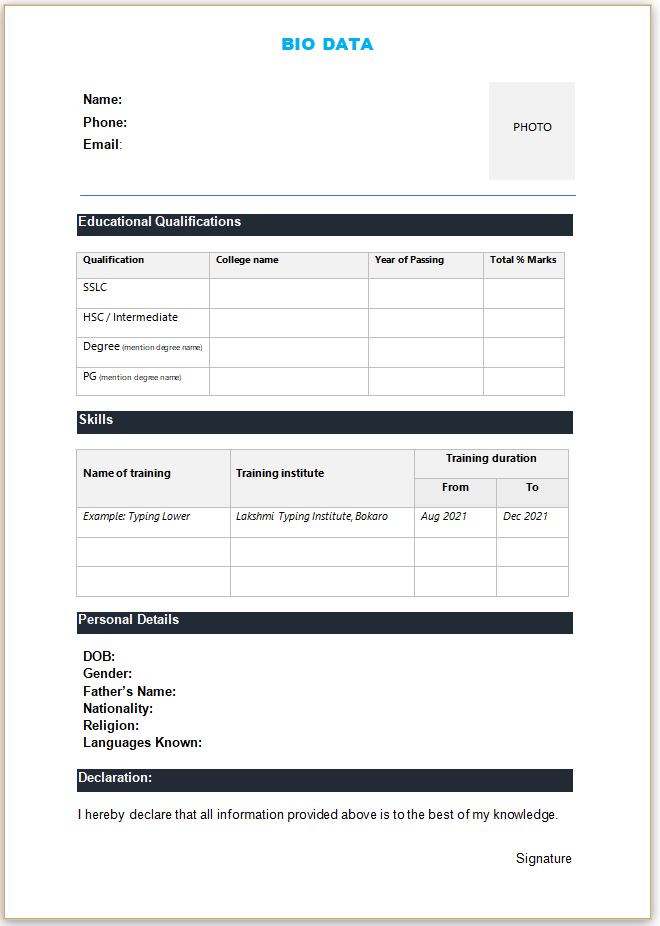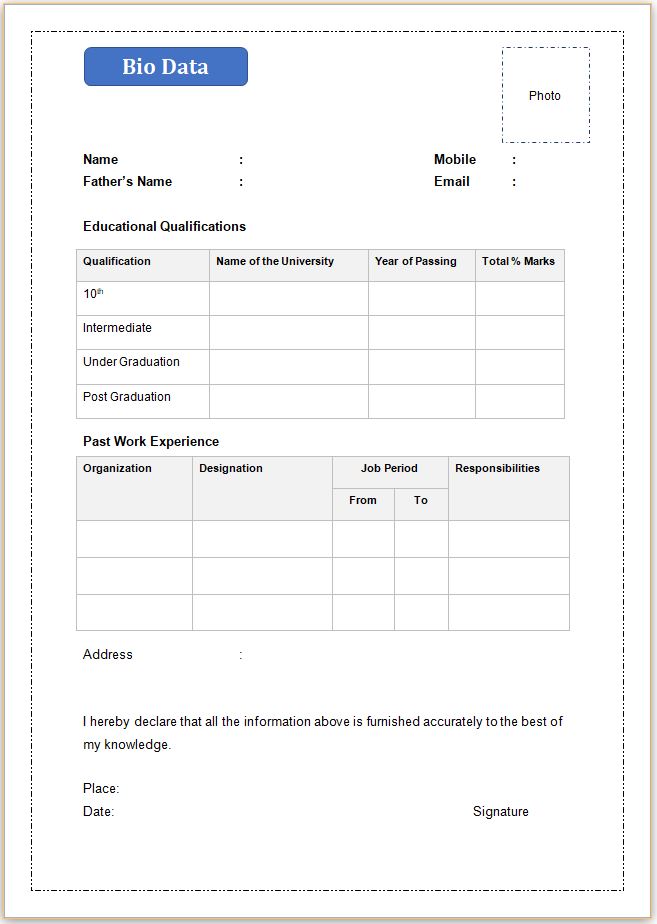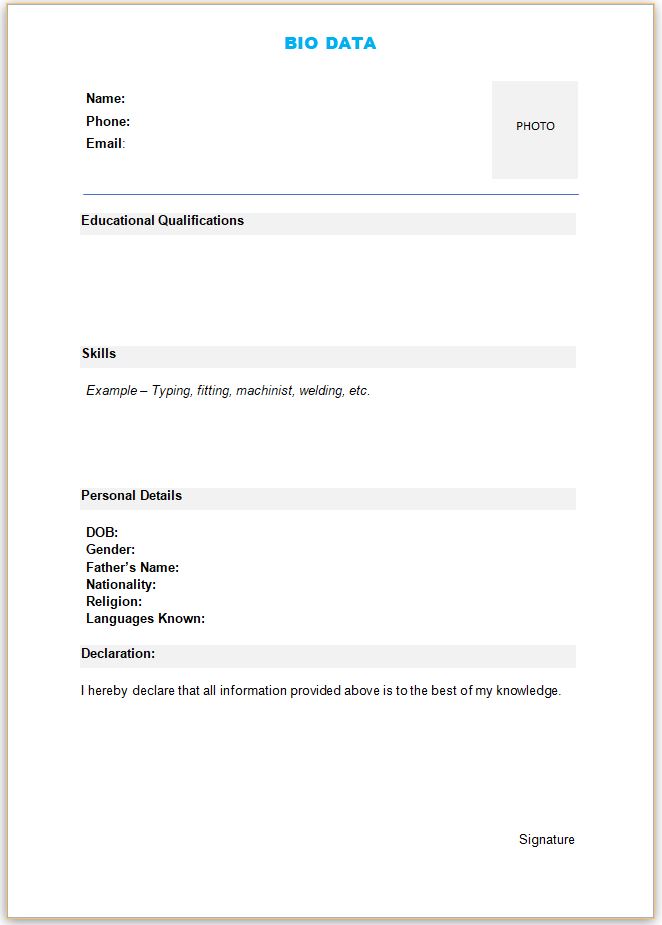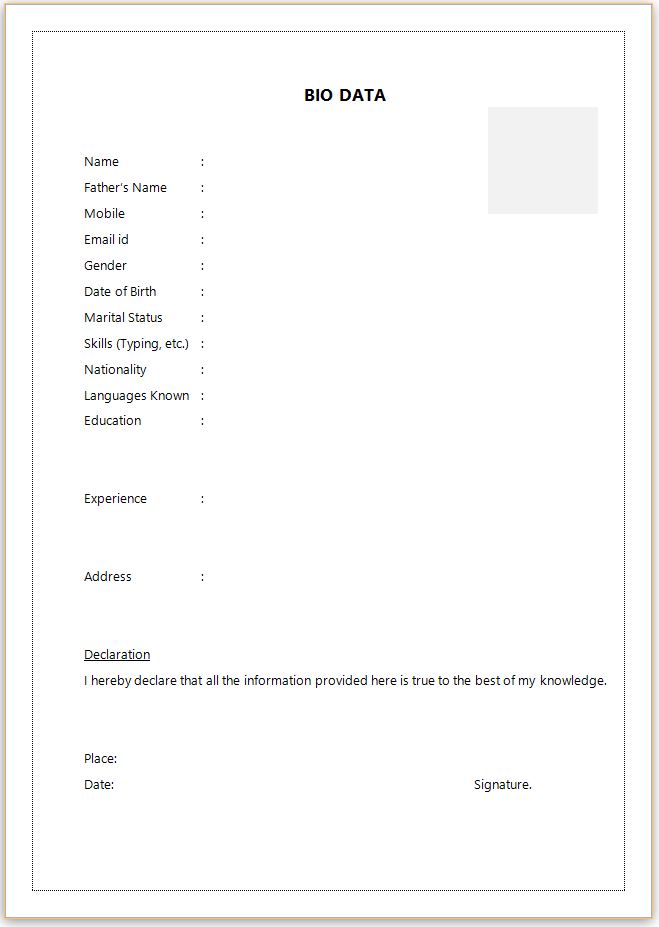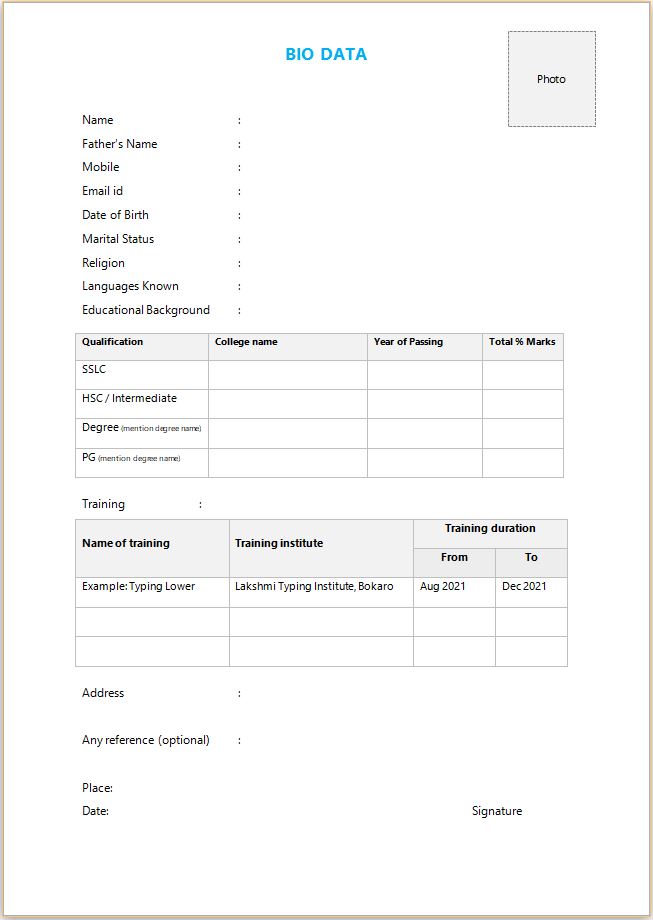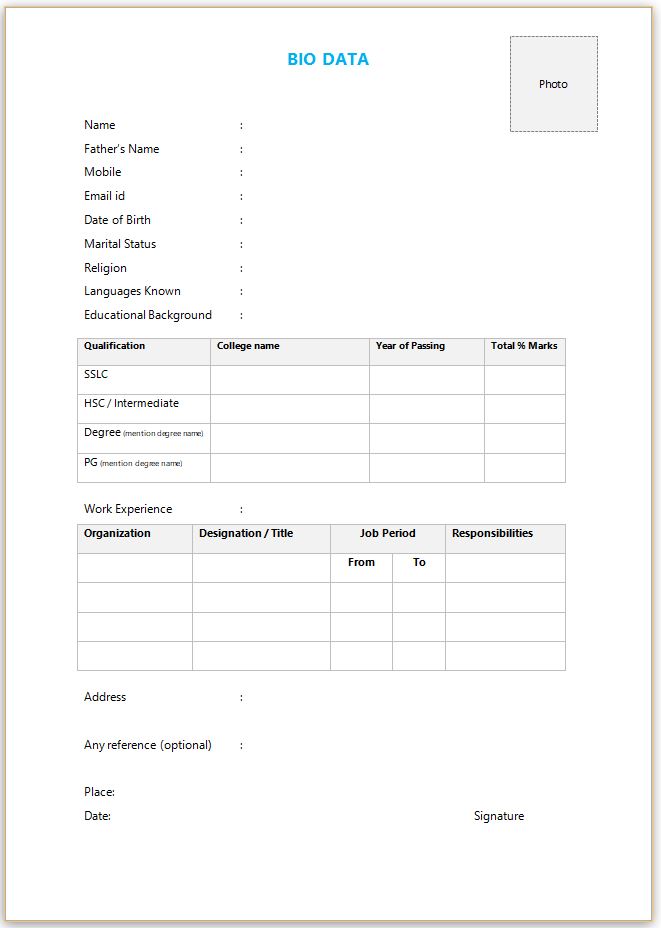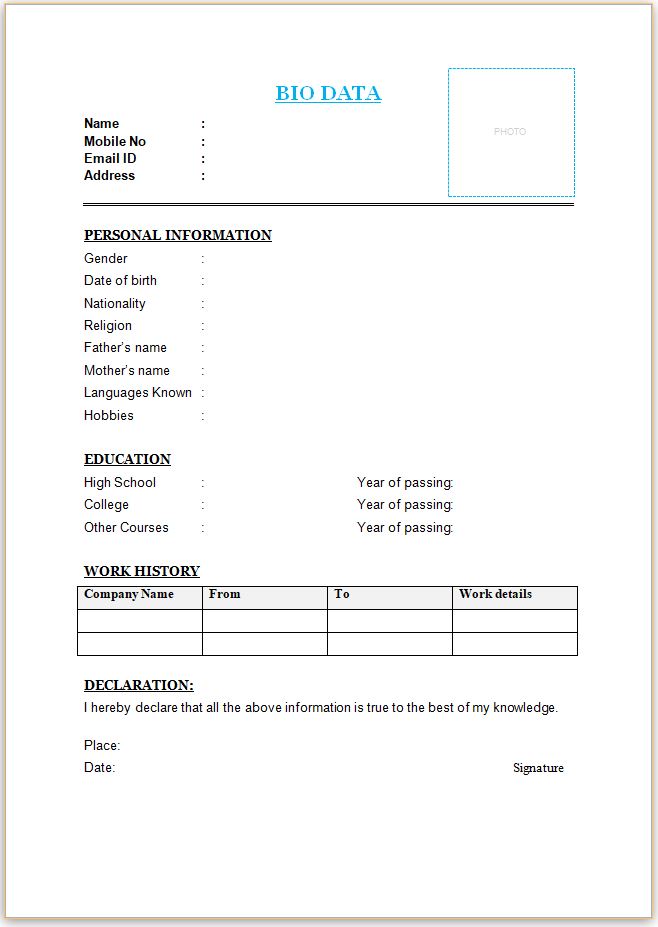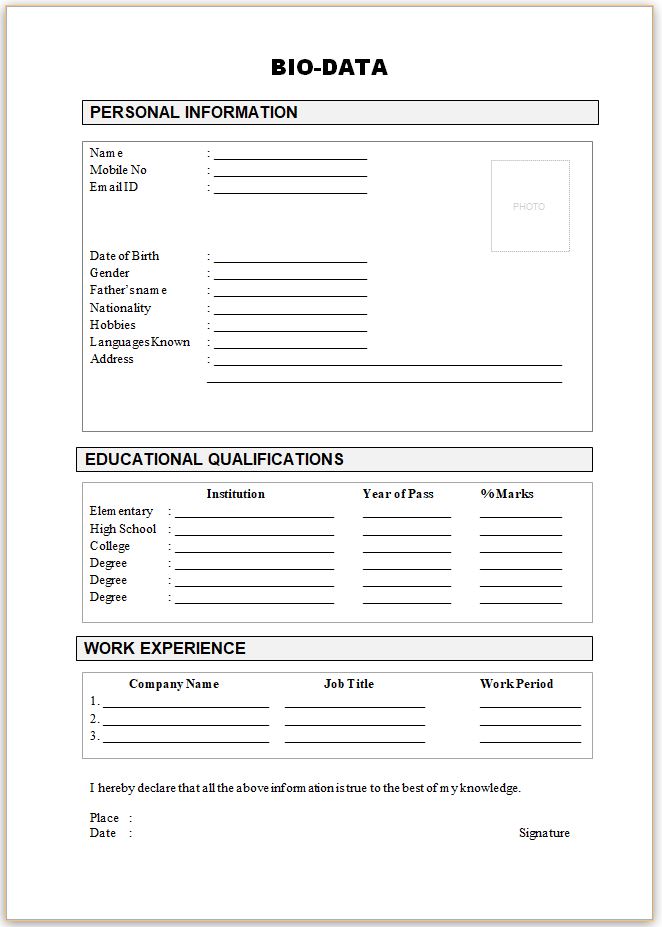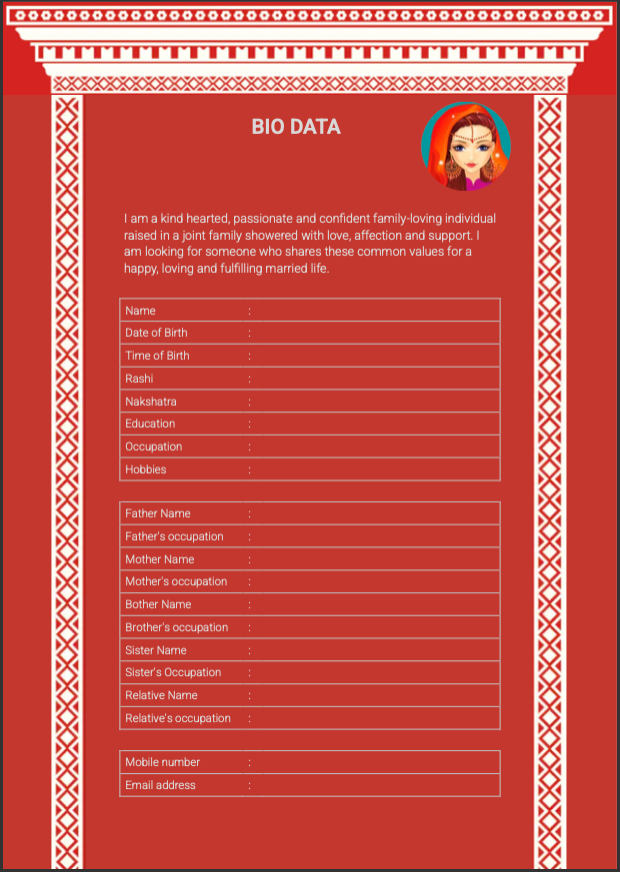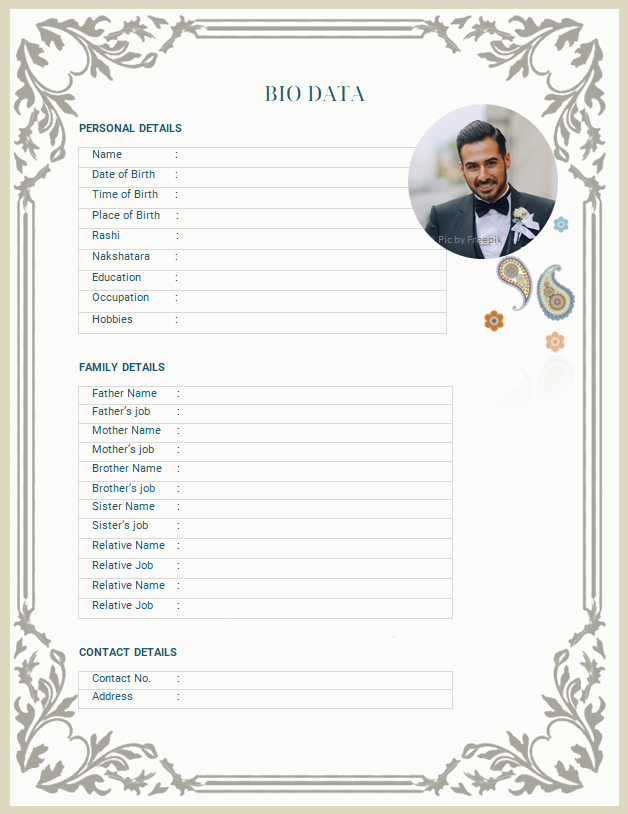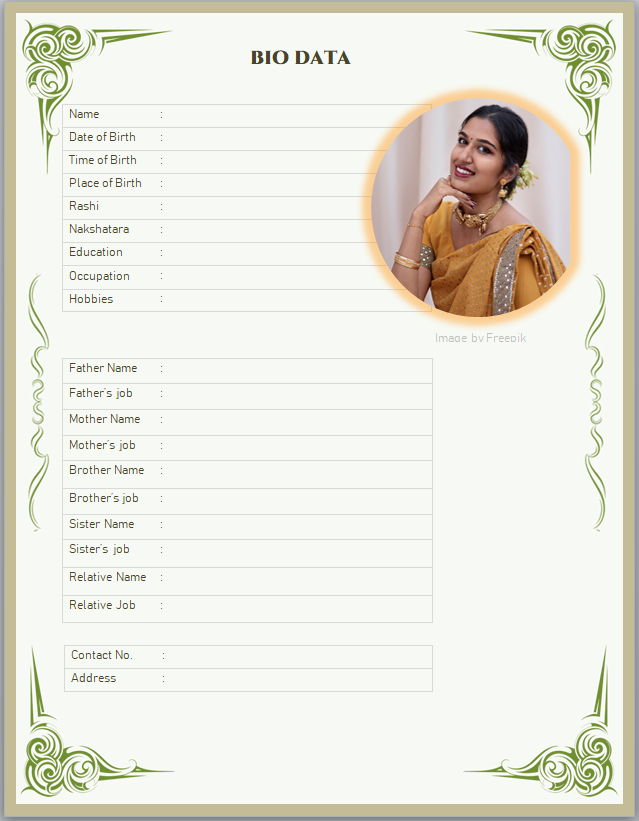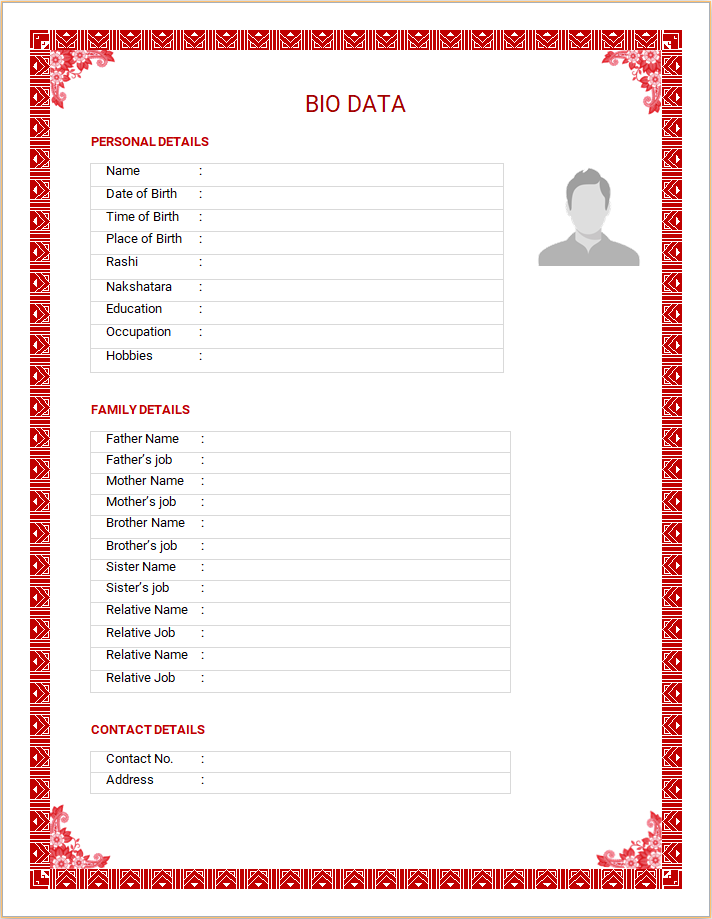Simple Bio Data Formats for Job PDF & Word Free Download

04 Feb 2024

How to Write a Bio Data in 2024
What is Bio-data?
Bio data (sometimes spelled biodata or bio-data) is a term used to refer to a written summary or profile of a person's personal, educational, and professional background. It typically includes details such as the person's name, address, age, educational qualifications, work experience, skills, hobbies, and interests, as well as any other relevant information that might be helpful for evaluating the person's suitability for a particular job, program, or opportunity. Bio data is commonly used in various contexts, including job applications, college admissions, matrimonial matches, and immigration processes.
How to Prepare Good Bio Data Format for Job
1. Start with a clear heading: Begin your bio data with your full name, address, and contact details.
2. Personal Information: Provide your personal details such as date of birth, gender, marital status, etc.
3. Educational Qualifications: List your educational qualifications in reverse chronological order. Include the name of the institution, degree/diploma obtained, and the year of graduation.
4. Work Experience: Mention your work experience, starting with the most recent job. Include the job title, name of the company, duration of employment, and job responsibilities.
5. List skills: List your skills and competencies that are relevant to the job or opportunity you are applying for.
6. Achievements: Mention any noteworthy achievements or accomplishments that demonstrate your capabilities.
7. Hobbies and Interests: This section is optional, but you can include your hobbies and interests to show your personality.
8. References: Finally, provide the names and contact details of at least two professional references who can vouch for your skills and character.
Additionally, It's important to ensure that your bio data is well-organized, concise, and easy to read. Use bullet points, headings, and spacing to make it visually appealing and easy to navigate. Additionally, tailor your bio data to the specific job or opportunity you're applying for, highlighting relevant skills and experiences.
Free to download Bio Data samples in Word Format
Below are some free to download Bio Data formats in word format. You can use these for a vareity of purposes. You can use these Bio Data formats for job applications, marriages and just about any professional endevours.
To download any of the bio data formats, just click the image and click the download button.
Free Marriage Biodata Formats in MS Word
To download these free marriage biodata formats all you need to do is register an account on our platform and you can download any template you like. These are handcrafted by our expert designers and we are offering these as completely free for your personal use.
Creating an Impressive Matrimonial Biodata
When it comes to finding the perfect life partner, a well-crafted matrimonial biodata can significantly enhance your chances of making a positive impression. Unlike resumes or CVs, a matrimonial biodata focuses on personal details, family background, and preferences. Here's a step-by-step guide on creating an impressive matrimonial biodata:
1. Personal Information
Start with your basic personal information, including your name, age, height, and contact details. Ensure accuracy and provide clear details about yourself.
2. Educational Background
Highlight your educational qualifications, starting from the highest level of education. Include details about the institutions you attended, degrees earned, and any notable achievements.
3. Professional Details
Share information about your current occupation, job role, and employer. Mention any professional achievements or recognitions you have received.
4. Family Background
Provide a brief overview of your family background, including the names and professions of your parents and siblings. This helps in giving a broader perspective to potential matches.
5. Hobbies and Interests
Include a section on your hobbies and interests to showcase your personality. Whether you enjoy reading, traveling, or pursuing specific activities, this adds a personal touch to your biodata.
6. Partner Preferences
Clearly outline your preferences for a life partner. This may include factors such as age range, educational qualifications, profession, and any other specific criteria important to you.
7. Contact Information
Provide accurate contact information for communication. Include your email address and phone number to make it easy for interested individuals to reach out.
8. Add a Recent Photograph
Include a recent and clear photograph of yourself. This helps in creating a visual connection and allows potential matches to see you before making contact.
Remember to keep your matrimonial biodata concise, sincere, and reflective of your true self. Avoid exaggerations and be honest in presenting information. Use a clean and organized format for better readability. Creating a compelling matrimonial biodata can significantly contribute to finding your ideal life partner.
Difference Between Bio Data, Resume, and CV
The lack of understanding of the difference between bio data, resume, and CV can cause issues for job aspirants. For example, if an applicant from India submits a bio data when applying for a job in North America, the employer may not be familiar with the document and may mistakenly assume that the applicant has not submitted a proper resume. Similarly, if an applicant submits a CV for a job application in a country where resumes are typically used, the employer may find the document too lengthy and detailed for their needs. In addition, using the wrong document may give the impression that the applicant is not familiar with the local job market or norms, which may harm their chances of getting the job.
It is important for job aspirants to understand the differences between these documents and to use the appropriate document for the job and the local context. They should also be aware of any local conventions or requirements regarding the format and content of the document, as this can vary from country to country and even from industry to industry.
What's the difference? Bio data, resume, and CV are all documents that provide information about a person's personal, educational, and professional background. However, they differ in terms of their length, purpose, and context of use.
Bio data is a brief document used in Indian contexts for job applications, matrimonial matches, and immigration processes.
Resume is a short document, usually one or two pages, that is tailored to a specific job application and used in North America and some other countries to showcase an applicant's qualifications and suitability for the job.
CV is a comprehensive document that provides a detailed summary of a person's academic and professional achievements, publications, research, and other relevant information. It's typically used in academic and research contexts and is not tailored to a specific job application but rather presents a complete picture of the applicant's qualifications and achievements.
When to Submit Bio-Data, Resume or CV
If you are looking for a job, create a resume. If you are asked for a bio data, then prepare a bio data. If you are applying for a PhD program or a teaching or a research position, then prepare a CV. If no information is provided, someone asked you information about your qualifications and experiences, you are better off preparing and sending a resume. If you ahve no idea about any of these, use one of the templates you like from below.
We have a lot of resume templates based on the degree you have and the kind of job you want.
Frequently Asked Questions about Bio Data
What is the format of the biodata?
There is no standard format for Bio Data. While you can prepare Bio Data in so many ways, there is no rule or a standard format on bio data. Usually it is best to keep Bio Data to just one page and limit to basic information about yourself. Adding a picture to the Bio Data may be a good idea.
How many pages my bio-data should be?
One page. Please keep your bio data to one page. There is no reason for your bio data should be more than one page. You will very likely print your bio data at home or at a photocopying shop. Make sure the operator at the shop does not change the margin settings to avoid your bio data from getting printed to two pages. So, first print your bio data and then paste your photo, if you are going to add your photo. Unless specifically asked, do not include your photograph.
What is better to apply for jobs? Bio data or Resume?
Resume. If it is not clearly mentioned whether a resume or a bio data is needed by your employer, we would recommend that you send the resume. Resume is the standard professional summary document these days in most of the organizations. Again, double check the job advertisement as to what document is requested. Usually those that want Bio Data would mention in the advertisement clearly that they want a Bio Data.
Can I send both Resume and Bio Data if I have both?
No. Send only one of the documents. Do not send both. Please do not send both.
Should I add From and To address to Bio Data
No. You do not need to add From and To addresses on the Bio Data. To avoid any confusion, download one of our templates and just fill up the details.
Mistakes to avoid in making Bio Data
When creating a biodata, there are a few common mistakes that you should avoid:
1. Including irrelevant information:Your biodata should only contain information that is relevant to the position you are applying for. Avoid adding irrelevant details like personal preferences, hobbies, or unrelated work experience.
2. Overloading with information:It's important to keep your biodata concise and to the point. Avoid including too much information or using complex language that might confuse the reader.
3. Providing incorrect or incomplete information:Make sure that all the information in your biodata is accurate and up-to-date. Providing incorrect or incomplete information can hurt your chances of getting hired.
4. Poor formatting:Your biodata should be easy to read and well-organized. Use clear headings, bullet points, and a legible font to make it easy for the reader to skim through.
5. Grammatical errors and typos:A biodata with grammatical errors and typos can give the impression of carelessness and lack of attention to detail. Always proofread your biodata carefully to ensure that it is error-free.
6. Including a photograph:In some countries, including a photograph is mandatory, but in others, it's not necessary. If it's not required, avoid adding a photograph as it may lead to discrimination based on appearance.
